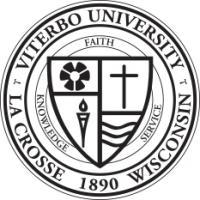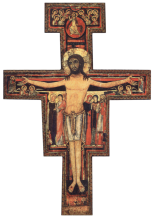The University Seal
Using symbols and words, the university seal reveals the rich history of Viterbo based on mission and purpose. The original seal, which has twice been slightly modified, was created in the early 1960s by Imogene Thiele, FSPA, a member of the art department.
Designed according to the science of heraldry, the shield located in the center of the seal contains a wealth of information. Clockwise from upper right: the cross symbolizes Christian identity; the wavy lines portray the Black, La Crosse, and Mississippi -Rivers, which join forces in La Crosse to provide -Viterbo with its unique geographic location; the torch of learning symbolizes the chief function of the -university; the rose honors St. Rose of Viterbo, the patron saint of the Franciscan Sisters of Perpetual Adoration, the founders of Viterbo.
Beyond the shield, the word “knowledge” is retained from a very early Viterbo motto taken from the -Bible: “Teach me goodness, discipline, and knowledge” (Ps. 118:66). Later “faith” and “service” were added to complete the virtues to be embodied in a liberal arts education.
The final elements contain basic information specific to Viterbo’s location, in La Crosse, where the mission of Viterbo University began in 1890. Two small tau crosses are to be found in the outermost ring, proclaiming the Franciscan heritage of Viterbo. The tau was the standard cross in the days of St. Francis, and it is formed by the Greek letter “T.”
With its rich symbolism, the university seal is a constant reminder of Viterbo’s past as well as a guide to the future for all who are here today.
Honors
Honor medallions are worn by bachelor degree students who have achieved a cumulative grade point average of 3.50 or above and will have earned a minimum of 45 letter-graded credits at Viterbo University upon completion of all requirements.
Candidates for graduation wearing the cardinal stoles have completed the Viterbo University Honors -Program. The military stoles are being worn by candidates for graduation signifying their service in the U.S. Armed Forces.
In addition, candidates for graduation may qualify to wear cords signifying contributions or achievements to a university organization or academic honor society. The organizations are represented by the following colors:
- Chi Sigma Iota Counseling Academic and Professional Honor Society (mental health counseling) — blue and white
- National Society of Leadership and Success — black and platinum
- Phi Alpha (social work) — blue and gold
- Pi Lambda Theta (education) — yellow
- Psi Chi, the International Honor Society in -Psychology — platinum and dark blue
- Sigma Theta Tau (nursing) — purple
- Student Government Association — cardinal and silver
- Tri-Beta (biology) — red and green
- Veterans of Armed Services — red, white, and blue
-
Delta Mu Delta (business)- purple and gold
The San Damiano Cross
In lieu of the university mace, which is often the traditional symbol used by institutions of higher learning, the San -Damiano Cross has come to represent Viterbo.
The San Damiano Cross is the sacred symbol before which Francis of Assisi prayed and heard God’s commission to “rebuild the church.” This icon was painted some time shortly after the first millennium, at a time when the authentic humanity of Jesus was becoming more appreciated in the faith life of the people. In the early centuries of the Christian communities, the divinity and royal priesthood of Jesus was emphasized. The San Damiano Cross pictures the luminous figure of the resurrected Christ radiating out from a dark and deathlike background. He presides over an all-inclusive cloud of witnesses: companions and friends, souls who have gone before him, and heavenly spirits. All of these figures have the hand of God pictured over them in a blessing. The
crucifix is a distinctive art piece used by those who practice a -Franciscan spirituality.
The San Damiano Cross is a symbol of the Franciscan heritage and identity of Viterbo. It attempts to stress the promise by God of a future that will respond to human hope. It affirms the continuity between the exercise of human freedom in this world and the final state of things. It draws all into the reality of God’s life. The San Damiano Cross offers a true and contemporary symbol for Franciscan higher education.
History
The academic dress worn today for ceremonial occasions originated in the universities of the Middle Ages when classrooms were unheated and the academic gown and hood kept scholars warm. It became a distinctive symbol of academic pursuit, setting the academic apart from the non-academic, hence the phrase “gown versus town.”
The gown was standardized in the U.S. in 1894 when the American Intercollegiate -Commission determined that all robes would be black. The master’s robe is distinguishable by long, closed sleeves; the doctor’s gown by a facing of black velvet from the hem to the neck and back, with three velvet bands around each sleeve above the elbow.
The traditional hood, also black, displays significant colors. The lining represents the colors of the university granting the wearer’s highest degree. The color of the hood facing signifies the individual’s academic discipline or school of study.
Although there has been much innovation in gown and cap design in recent years, the standard colors representing the various academic disciplines have remained the same: white (arts and letters), purple (law), scarlet (theology), dark blue (philosophy), yellow (science), brown (fine arts), pink (music), copper (economics), lemon (library science), light brown (business), light blue (education), citron yellow (social work), white (mental health counseling), white (nutrition sciences), and apricot (nursing).
Flags
The colored flags displayed on stage represent the -academic disciplines offered by Viterbo University. The -international flags also displayed on the stage today represent the home countries from which candidates for graduation have come. The displaying of flags is intended to show Viterbo University’s commitment and respect for a diverse community.

